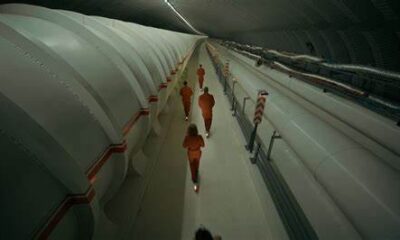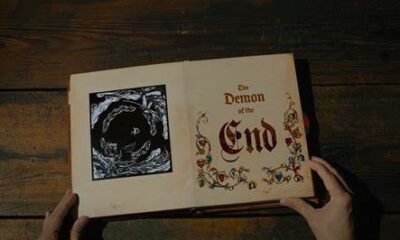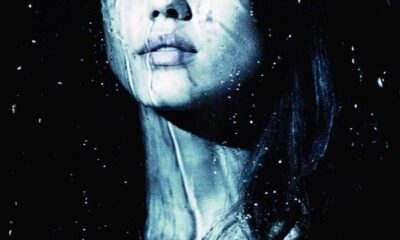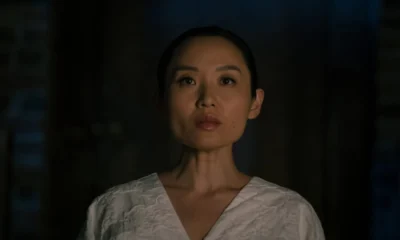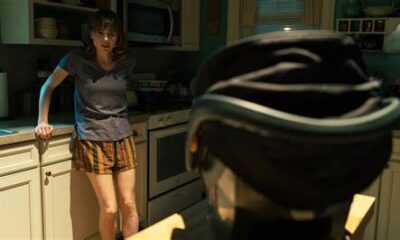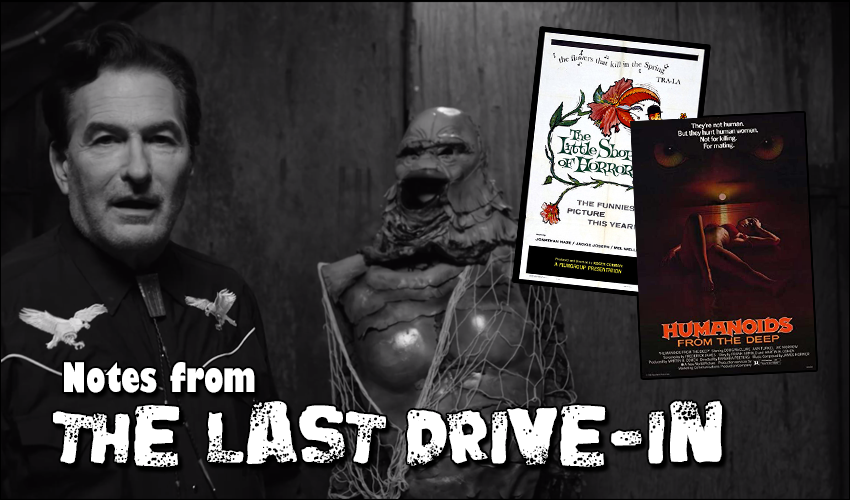
Notes from the Last Drive-In: S3E10 – The Little Shop of Horrors and Humanoids from the Deep
Tonight a living legend (who isn’t Joe Bob Briggs) makes an appearance on the show as Roger Corman walks us through The Little Shop of Horrors and Humanoids from the Deep. Can you believe it? Another season of The Last Drive-In with Joe Bob Briggs is over and done. We are also leaving the cabin in New Jersey, where the show has been since the pandemic started. It was a great night with solid movies and a sense of transition that, as we have seen on the show before, may also work as a series finale until Shudder finally confirms season 4.
So, how were the movies? What absurd cosplay did Darcy whip up? How many dogs were killed on screen this week? Let’s find out!
The Little Shop of Horrors (1960)
Opening: There is only one type of gym that gets the Joe Bob seal of approval: a real shithole.
Shot in the tail-end of the 1950s over the span of two days, Roger Corman’s The Little Shop of Horrors is one of those important chapters of film history as a foundational independent project. Roger Corman directed the film, written by Charles B. Griffith. There is some suggestion the film could have been inspired by few other carnivorous plant stories floating around, but that is a murky debate. The film also should not be confused with the later Broadway musical, which was the foundation of Frank Oz’s 1986 film. All of this emphasizes the influence of this film, and more to the point, Roger Corman on the world of film as Drive-In fans and mutants have come to know it.
The Little Shop of Horrors stars Jonathan Haze, Jackie Joseph, Mel Welles, and Dick Miller with a very brief appearance by Jack Nicholson, which became a major part of advertising the film in the decades since release. The whole cast is filled with Corman’s regulars, who could pull together an incredibly tight production. The movie follows Seymour Krelboined, a gardener in Mushnick’s flower shop who raises a strange plant that blossoms when it feeds on blood. What follows is a black comedy with elements of farce, rapid-fire dialogue, and a little bit of then-contemporary spoof. The cast finds themselves learning about the hunger of the plant and sometimes succumbing to it.
As a whole, the film is great. It is worth every bit of praise it deserves, even without factoring in the incredible circumstances of its production and conception. And Roger Corman, more known for his latter role as a producer, has great directorial chops here, rounding up disparate elements into a workable and compelling story. With that being said, sometimes the lassoing of broader ideas is a little more obvious. The dental scene, a classic, feels like more of an aside than a pivotal part of moving the story forward. The entire movie has this quality to an extent, feeling very stitched together but done well. It is just that some of the seams are fairly obvious. Given the speed at which the film came together, even in scripting, this isn’t surprising and is a testament to the talent of everyone involved. These issues are largely ironed out in Frank Oz’s musical adaptation in the mid-eighties, such as dropping the detectives and their narration.
The film does look rough in spots, with an obvious set for the flower shop, but it is also ridiculously charming, especially the Yiddish-influenced, handmade signs. Any time the movie is set outdoors, however, the screen becomes a blobby, shadowy mess. This isn’t uncommon in black and white films, and The Little Shop of Horrors is another example of this reality of limitations in 1950s films.
The film’s draw is the dialogue and the cast that delivers it with an incredible level of old Hollywood energy. Joe Bob mentioned that during the show, and it is something any film fan would be aware of – the dialogue was just faster back in the day. As for the crew, the four highest-billed actors, except for Nicholson, given his minor role, deliver masterclass performances. Jonathan Haze’s Seymour Krelboined is a neurotic, easily bullied bundle of anxiety that plays off every other character. Much can be said about Mel Welles’ blustery, scene-chewing Gravis Mushnick, but his performance is strengthened by the work Haze puts in. Another example of Haze’s talent comes with nearly any scene involving his hypochondriac mother, played by Myrtle Vail. In those moments, hilarious jokes fly fast, and the energy between them is stunning. Of course, Jackie Joseph is also fantastic as Audrey, playing a charming woman, but not adding much else, fairly common for the time, sadly.
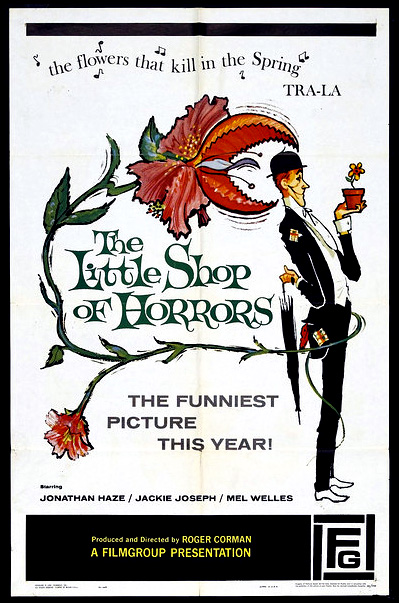
It is no shock that Joe Bob Briggs, a Roger Corman super-fan, has high praise for the film. He provided several great details about the production and crew, but the night’s theme was mostly a tribute to Roger Corman, who served as the final guest of the season. Corman stuck around for both films, and his interviews were fascinating, particularly when it came to the craft of film production. It just seems like further evidence Joe Bob needs a second show where he talks to talent.
One of the best bits from the host segment revolved around just exploring how influential Corman was. He is a modest man, so Joe Bob had to do a lot of the direction of the conversation in that regard, seeding stories for Roger to build on. The stories, though? Incredible, such as Roger’s experiencing taking acting classes and the ridiculous number of contacts he established by taking those classes.
The Little Shop of Horrors is a classic film and an important piece of film history. It is not without its problems, however. Those problems made the film a bit more charming and ultimately allowed Frank Oz’s later adaptation to do its own thing – and quite well. They’re two different experiences grown in the same soil, but each stands on its own. Joe Bob Briggs gave The Little Shop of Horrors four stars, which is a fair, reasonable assessment of the movie. I am more of a fan of the musical, but I can recognize the original as the art it is. I still have some hangups regarding the film’s structure, but it’s definitely an objectively great film. I give it four and a half Cthulhus out of five.
 (4.5 / 5)
(4.5 / 5)
Best Line: “Now, no Novocain. It dulls the senses.” – Wilbur Force, Jack Nicholson’s kinky dental customer.
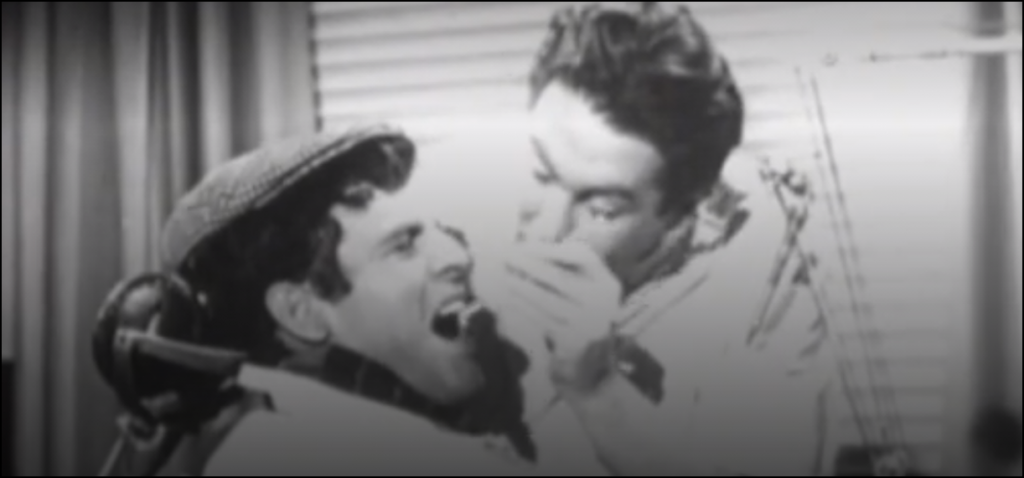
Humanoids from the Deep (1980)
Opening: Building on the energy of The Little Shop of Horrors… we’ve slowed down as a society.
Ah, Humanoids from the Deep. We are firmly in the Roger Corman production era, and perhaps Roger at his absolute heights as a figure in the industry with this film. Is it the best of the films Roger Corman produced under New World Pictures? Not really. But it is enjoyable and a great slice of what ended up a career retrospective for this evening on The Last Drive-In. The film has all the ingredients necessary for a Drive-In movie and absolutely delivers on all three fronts: blood, breasts, and beasts.
Humanoids from the Deep (or, MONSTER!) is a 1980 science fiction horror film starring Doug McClure, Ann Turkel, and Vic Morrow. Like many movies that show up on the show, this one had a trouble production: the film is nominally directed by Barbara Peeters, but Jimmy T. Murakami’s uncredited contributions are the behest of Corman. The screenplay was written by Fredrick James, based on a story by Frank Arnold and Martin B. Cohen, who served as a producer as well. Another credit of note, the music was handled by none of than James Horner.
The movie follows the local fisherman and community of Noyo, California. They are menaced by brutally escalating assaults by mysterious assailants who turn out to be murderous, raping fish-men from a nearby fishing company. Also, there is a subplot about indigenous cultures being abused by settling whites, themes of environmentalism, and small-town toxicity. There is also a bizarre scene with a puppet. It’s a great movie for Drive-In Mutants. For the normals? Not so much.
The plot is pretty loose, really only stretching a thin story over a few scenes of monstrous encounters. Nothing about the story itself comes off as surprising, either. It’s all very much in line with other films with the same sort of themes, but coming into Humanoids expecting something revolutionary in the narrative is a fool’s errand. Instead, the appeal from the film comes from the discrepancy between the actors and the material, the effects, and the unique way the monsters are handled.
The performances in the film are good, generally, and great surprisingly often. Given the nature of the film, some level of trickery was employed to get the scripts passed from the agents to the actors, and Roger confirmed as much in the show. Specifically, the film was pitched as a “psychological drama,” which is fantastic because that is so not what this movie is. But because a payday is a payday, the actors put their all into it. The performances range from the oddly compelling, if not a bit basic Doug McClure, to the incredibly compelling in Anthony Pena’s Johnny Eagle, to the ridiculously cartoonish villainy of Vic Morrow as Hank Slattery. The fact these actors put so much effort into this movie about killer fish-men snatching up women and slashing up men is astounding.

Oh, and those fish-men are amazing. A sizeable chunk of the film’s $2.5 million budget was wisely spent on the monster costumed by the legendary Rob Bottin (The Thing, RoboCop, The Howling). The monsters are damn good, especially when they emerge from the water. They also hold up incredibly well in a few underwater scenes. They are inevitably a bit goofy looking, as they are bipedal mutant salmon, but the elongated arms and strange features are the scary sides of goofy.
The movie, really, is all just set up from the final twenty minutes or so, featuring a massive attack on a local festival by the fish-men. It is a tight little film at under 80 minutes, but the story is mostly treading water until the attack. The film also, and perhaps most novelly, shows the monsters early on. Most creature features obscure the monster until the end. With Humanoids from the Deep, you’ll have seen at least a couple of the monsters in full during graphic sexual assaults or bloody slashing by the end of the first third of the film.
Joe Bob’s host segments continued to pull great anecdotes out of Roger Corman, especially on whether people can still produce films his way in today’s industry. To summarize Roger’s exquisite point: it’s hard today but still possible. Most of the other segment highlights were the increasingly absurd “six degrees of Roger Corman” reveals that emphasize his importance to cinema as a whole. Gale Anne Hurd? Martin Scorsese? Roger had a hand in shaping their careers. It’s astounding, really.
Humanoids from the Deep isn’t what you could call a great film, but it is a great movie if we believe such distinctions exist. Humanoids is entertaining and has a certain limited cultural relevance, but it’s not for everyone. This one is for the Mutants. By that assessment, Joe Bob Briggs’ four-star rating makes sense. I swim in a bit of a different stream in my reviews, though. I think it is a ton of fun and one I’d watch again and again, but it’s not one I would argue is great. I’d give it about three and a half Cthulhus.
 (3.5 / 5)
(3.5 / 5)
Best Line: “Oh, come on, show me more than the head.” – Becky, talking about a ventriloquist dummy.
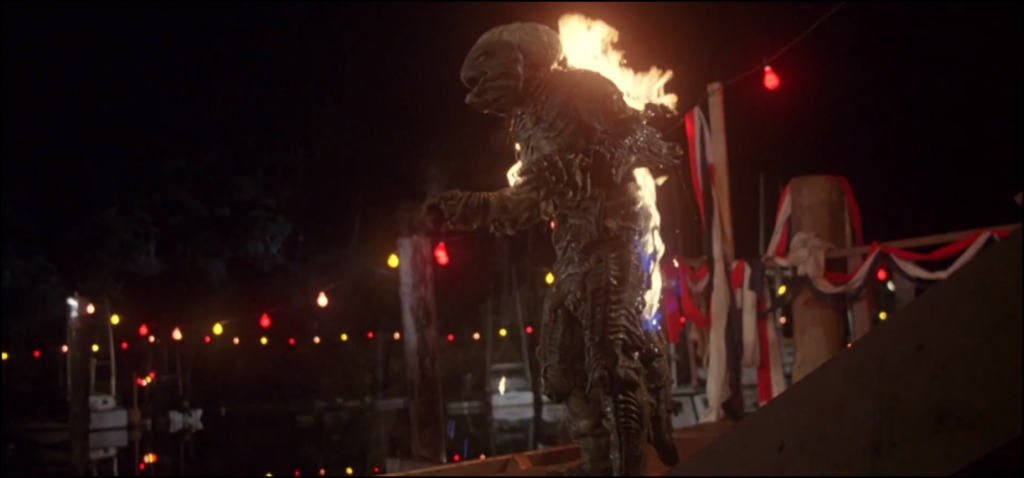
Haunted MTL Drive-In Totals
Our final drive-in totals of the season. I miss them already.
As for our totals:
- 2 day shoot
- 4 Yuki Sightings
- 6 Degrees of Roger Corman
- 9 gym rules
- 14 dead dogs this season
- 67 years of Roger Corman films
- Flower Eating
- Self Medicating
- Vulture Joking
- Rapid Fire Dialogue Fu
- Self-financed Fu
- Darcy Cosplay: Audrey (the 1986 version), and a Humanoid… from the Deep!
- Silver Bolo Award: Good Bad Flicks
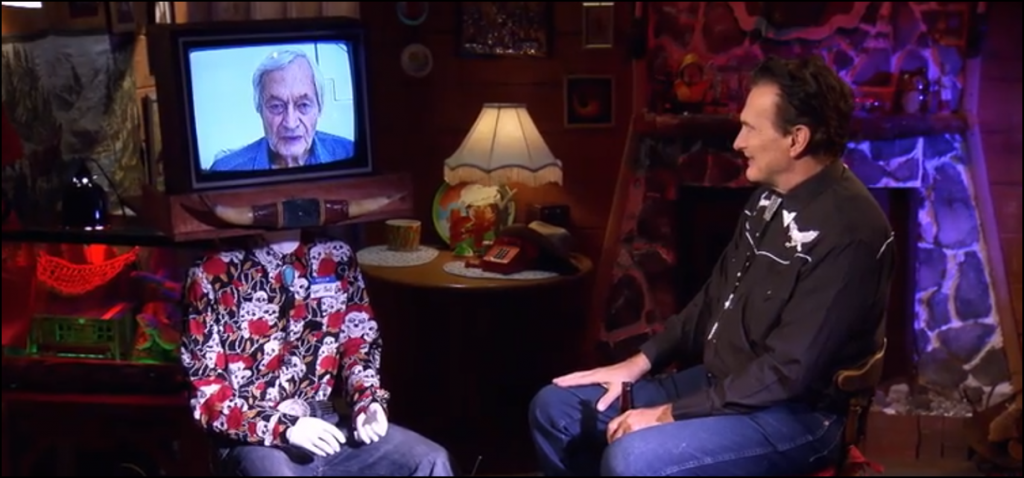
Episode Score
Tonight seemed to be the end to what I hope will be dubbed the “Cabin in the Woods”-era of the show, which means I also hope we’ll have multiple eras of The Last Drive-In. I know my criticisms of the isolation of the cabin set and some remote guests have been a running theme through my reviews of the season and the previous specials. Still, I ultimately feel this will be a nostalgic chapter of our collective Drive-In experience. It’s interesting how seeing Joe Bob and Darcy (in Humanoid cosplay) evokes that nostalgia, which of course, is the overall reason why Mutants tune in week to week to watch the show on Shudder, to begin with. Nostalgia, whether drawn from movies we know, or even the comforting presence of a guy in a bolo tie drinking beer and waxing wise about a movie, is something that we needed to get through the last year or so.
So, I guess while I had my gripes with the cabin, I am ultimately going to miss it. Funny how that will work – there will be the inevitable nostalgia. I think we’re going to be able to continue building memories of the show for a while to come. The slickly-produced Drive-In Oath between the two films felt like something you would produce for a show you plan to keep around, not send-off. Time will tell. Regardless, as with every season and special, we come to a close with a wistful Joe Bob and something that can work as the last Last Drive-in.
 (4.5 / 5)
(4.5 / 5)
Lastly, if you want a little more Joe Bob while you wait for the next special, consider Join Darcy’s Patreon, The Lost Drive-In. I am a member and have already received a great Blu-Ray full of great Joe Bob bits from his previous shows. She also posts fun clips from the archives on show nights, so there is a ton of stuff you can enjoy.
Movies n TV
Wheel of Time A Question of Crimson Is a Political Espionage Delight
Episode two of Wheel of Time felt like the beginning of a long journey. Stories are unfolding, lives are changing, and blood is spilling.
Let’s discuss.
The story
We begin this episode in the past with Elayne’s mother, Queen Morgase. It turns out her rise to the throne was a bit, shall we say, cutthroat. So when she shows up at the White Tower, Siuan is concerned.
She might have reason to be, too.
Meanwhile, Rand, Egwene, Moiraine, Lan and Aviendha are in the Spine of The World. As they travel through some of the most breathtaking lands I have ever seen on a TV show, Egwene is plagued with nightmares. We think at first that’s just her trauma working itself through her system. But we soon find out that it might not be that straightforward.
Finally, Perrin returns home to heal after his hand is almost cut in half. But when he gets there he finds the town has been infested by Children of The Light. And they’re looking for him.
What worked
There was something heartwarming in this episode about political espionage and choking religious persecution. And that is Elayne’s relationship with her family.
I have consumed a lot of fantasy content with royal families. And I have never once heard a princess call her mother ‘Mum’. I’ve never seen royal siblings get along. And I have sure as hell never seen a princess have a good relationship with her step-parent.
This was refreshing. Even though Queen Morgase is kind of a horrible person she seems like a good mother. And that’s an unexpected delight.

Of course, this is just one storyline among many. And while this can sometimes be overwhelming, in this case it wasn’t.
I’ll be honest, some of these storylines are going to drag for me. I know this because I’ve read some of the Wheel of Time books and I have an idea that not all the characters exactly pique my interest.
No one likes all the characters. No one likes all the storylines. While I am here for the political espionage between Queen Morgase and Siuan, not everyone likes it. While others might be fascinated with Selene trying to win Rand back, I couldn’t care less.
Having multiple storylines keeps everyone’s attention better. So long as things don’t get out of hand. Things can easily get out of hand. But this seems to be managed well.
So far.
What didn’t work
As I mentioned above, I’m not thrilled with Rand’s story at this point. And while it’s fine to not like a storyline when there are this many to choose from, it’s not fantastic that the one I like the least is the one involving our two main characters. And anytime we were with the team at the Spine of The World, the only thing that brought me joy was Moirain’s hat. It reminded me of Stockard Channing’s hat in Practical Magic.
The problem is that Rand is Charlie Brown with controversial magical powers. He is boring, serious, and pessimistic.
And yes, I understand that he has a heavy emotional burden and he’s the Dragon Reborn and that’s quite taxing and all. But let’s be fair, there isn’t a single person in this show that doesn’t have a heavy burden. And most of them manage to be fun occasionally.

All that being said, this episode of Wheel of Time did exactly what it needed to do. It set up conflicts at each of the three locations. It established emotional ties between the characters and the events. And it established goals for everyone.
This was, in short, a solid episode. Not groundbreaking, not mind-blowing or life changing. It was simply good. It was entertaining and moved the plot forward.
Well done.
 (3.5 / 5)
(3.5 / 5)
Movies n TV
Wheel of Time Returns With A Bang
Wheel of Time is back for season three. There are mixed feelings regarding this. Last season, there were some serious pacing issues. And some serious sticking to the book’s storyline issues. But we’re two seasons in, and we don’t give up so easily. So let’s dive into episode one, To Race the Shadow.
By the way, I highly recommend watching this episode with the subtitles on. You’ll see why.
The story
We begin this episode with Liandrin facing a trial of sorts for her rampant betrayal. She does her best to gaslight her Aes Sedai sisters into thinking that Siuan Sanche is the real traitor.

When that doesn’t work, she reveals how many Black Aes Sedai have actually infiltrated the tower.
Spoiler, it’s a lot.
In the aftermath, our whole team gathers to drink and enjoy one night of relaxation before they head out to the Tear to form an army for Rand. All is going well until they’re attacked by myriad creatures and a sentient axe.
What worked
This episode was long. It had a run time of an hour and eleven minutes. And a lot of that run time was spent in heavy dialog scenes.
Fortunately, these were well-done scenes.
If you’re going to have a lot of talking scenes, there are good ways and bad ways to do it. Last season, we saw lots of examples of the bad way to do it. But this episode did it well. For one thing, other things were going on while conversations were taking place. The characters are drinking, playing games, walking through an interesting city. And the scenes themselves didn’t stretch out. They weren’t repetitive. We heard what the character had to say, then we moved on.
It was also nice that the point of these scenes wasn’t just info dumps. We had character development. We had romantic interactions. We had plot development and foreshadowing.
Overall, this episode felt like what it was. A moment of calm before a storm.
Taking a step back, I’d be remiss if I didn’t address the fight scene at the start of the episode. Because it was epic.
The magic looked amazing. The martial arts that went along with it looked fantastic. The costumes were beautiful. It was just incredibly fun to watch.
More than that, it was emotional. We lost some characters in that fight that were important. And it was clearly emotionally shattering for many of our characters, who found themselves betrayed by people they trusted.
So many of them.
It was a great way to open the season.
What didn’t work
Despite that, this episode wasn’t without its flaws.
First off, there were a lot of dialog scenes. And they were good scenes, as I’ve already discussed. But it was one after another after another. And when your episode is, again, an hour and eleven minutes, it’s maybe a little much to have so much chit-chat. Couldn’t some of these conversations, important as they were, have been moved to maybe another episode?
Finally, I want to talk about Egwene’s travel through the arches.

I feel like maybe there were some deleted scenes here. Because there must have been more to that visit than what we saw, right?
We could have seen Egwene battle Rand. That would have been badass and emotionally devastating. We could have seen her with a quiet life with Rand back home at the Two Rivers. We could have seen anything except for the quick clip of Rand in a bloody river, followed by Egwene being shoved back out in a bloody shift.
No products found.
Bad job. But at least it wasn’t an extended scene of Moiraine collecting bathwater, and then taking a bath while looking sad. If we’d started this season with another scene like that, it might have broken my brain.
Amazon dropped the first three episodes at once. So we’ll be back soon to talk about episode two. See you then.
 (4 / 5)
(4 / 5)
Movies n TV
Entertaining as hell: Eight Legged Freaks (2002) Review
Early 2000s is a special era for the industry. It accepts the cheesiness and corniness of movie making, in turn producing some gems in their own right. Eight Legged Freaks starring David Arquette and young Scarlet Johanson is a horror comedy about giant spiders who overtake a small town. As crazy as that premise sounds, the movie surprisingly has a ton of heart and is super entertaining. Let’s review, shall we?
Plot
We start Eight Legged Freaks with a shot of toxic waste spilling into the water supply of Joshua, a spider farm owner. He is friends with Mike, one of our protagonists, who is a science geek and a spider enthusiast. Mike notices something quite right upon visiting Joshua, but no one takes him seriously. We are then introduced to the rest of the crew. Mike’s mother Samantha, the town sheriff, is too busy chasing Ashley, his sister, who is dating the town mayor’s son Bret (something Samantha does not approve of). We also have Chris, who returns to the town to save his father’s legacy in the town mines. He has opposition from Wade, Bret’s father, who wants to use the mines for his business ventures. Lots of drama going on that will only get juicier once the spiders get loose.
The creepy crawlies quickly dispose of Joshua and make their grand appearance after Ashley rejects Bret’s advances, abandoning him in the middle of a desert. A glorious chase sequence ensues as the spiders make their way towards the town, wreaking havoc on its residents. In a true horror fashion (which the movie acknowledges), it takes some convincing from Mike and then from Samantha for the town to take the threat seriously. The tongue-in-cheek style of narrative adds the comedy aspect to a movie that would otherwise burn out fairly quickly.
The remaining characters hide out in a shopping mall as it’s the only somewhat sturdy building in the area. This doesn’t last long as the spiders break in, forcing them to run through the mines. Their resources to fight the creepy crawlies off are limited as the methane gas doesn’t allow them to use firearms. Such conditions require resourceful thinking from Chris, who uses perfume to fend off the leader of the spider group and save himself during the climax of the movie.
Character dynamics are not forgotten once the action kicks in. We have Chris confessing his long-term feelings for Samantha which she knew all along, which provided some comedic relief. Bret also reunites with Ashley and apologises for being an asshole. Mike finally gets the appreciation he deserves as his knowledge saves the townsfolk more than once during the whole ordeal.
We end the movie with the town’s radio show person telling the story as an urban legend during his segment. This brings it into question – how much of it happened the way he said it did? We can only guess…
Overall thoughts
Eight Legged Freaks is a fun creature feature with some self-aware commentary on genre tropes that doesn’t take itself too seriously. The acting is good, the pacing fitting and the characters are likeable enough for you to want them to make it through. Definitely a must watch, if you don’t suffer from arachnophobia, that is.
 (5 / 5)
(5 / 5)
- What do you get when you cross toxic waste with a bunch of exotic spiders? Eaten! The townies of Prosperity, Arizona will all become a screaming smorgasbord if mutated arachnids as big as SUVs have their way in this comedy/horror crowd pleaser whose creators include the producers of Independence Day and Godzilla
- Spiders that leap like gazelles, web-spitting spiders, spiders that suck your insides out as if through a straw—they’re all among the behemoths conjured up by an inventive effects team
- David Arquette (Scream) leads the two-legged stars, mobilizing the citizenry in a last-ditch fight to survive
Last update on 2025-03-10 / Affiliate links / Images from Amazon Product Advertising API


